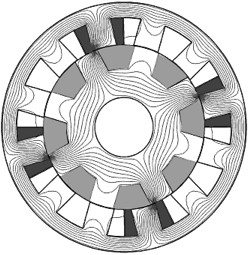Project lead Cobham Technical Services, working alongside Jaguar Land Rover (JLR) and Ricardo, hopes to eliminate the use of expensive magnetic materials in high-efficiency, lightweight traction motors.
‘Although electric machines have been around for a very long time, we are very much at the early stages of development of electrified powertrain systems and there is clearly a long way to go in terms of the optimisation of different architectures,’ Anthony Smith of Ricardo told The Engineer.
‘Key challenges include reducing the cost and effectiveness of energy storage [especially of batteries] and reducing the volume of rare-earth metals required in motors. This project addresses the latter imperative.’
The team will focus on the development of a powertrain based on switched reluctance motors. The key advantage of this type of motor is that neither the rotor nor the stator (stationary part) requires the use of permanent magnetic components — that is, materials that create their own persistent magnetic field (generally rare-earth metals).
Instead, the electromagnetic poles are manufactured from laminates arranged in pairs across the diameter of the motor. As each pair of stator poles is energised, the closest diametric element of the rotor will be attracted as part of a magnetic circuit and a torque is developed in the rotor shaft.
The number of rotor poles is typically less than the number of stator poles, which prevents the poles from all aligning simultaneously — a position that cannot generate torque.

Reluctance motors can deliver very high power density at low cost but are complex to design and control. As part of its work on the project, Cobham will develop novel multi-physics software. Using these new tools, JLR and Ricardo will design and manufacture a prototype switched reluctance motor that addresses the requirements of luxury hybrid vehicles.
Smith explained some of the technical challenges involved in this process.
‘For example, a rotor doing say 40,000rev/min could grow significantly, causing the gap to shrink so changing the magnetic circuit, and so the gap may have to be bigger to accommodate this growth,’ he said. ‘Currently, there are a number of different software tools for doing this but they are not linked, which causes the process to be torturous and expensive.’
The total value of this particular motor project is £1.5m, with half the amount funded by the Technology Strategy Board (TSB) and the Department for Business, Innovation and Skills (BIS) and the rest by the project partners.
The project itself is one of 16 collaborative research and development programmes to have won funding from the UK government-backed TSB and BIS, which have agreed to invest £10m aimed at achieving significant cuts in CO2 emissions for vehicle-centric technologies.


Project to investigate hybrid approach to titanium manufacturing
What is this a hybrid of? Superplastic forming tends to be performed slowly as otherwise the behaviour is the hot creep that typifies hot...